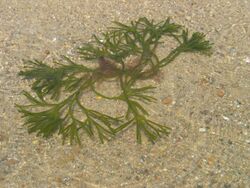Biology:Bryopsidales
| Bryopsidales | |
|---|---|

| |
| Dead man's fingers (Codium fragile) | |
| Scientific classification | |
| (unranked): | Viridiplantae |
| Division: | Chlorophyta |
| Class: | Ulvophyceae |
| Order: | Bryopsidales J.H. Schaffner |
| Families[1] | |
| Synonyms | |
| |
Bryopsidales is an order of green algae, in the class Ulvophyceae.[1]
Characteristics
The thallus is filamentous and much branched and may be packed into a mass. It is coenocytic, having multi-nucleate cells consisting of cytoplasm contained within a cylindrical cell wall. There are no septae and the many discoid chloroplasts, nuclei and other organelles are free to move through the organism. The whole organism may consist of a single cell and in the genus Caulerpa this may be several metres across. In the genus Halimeda, whole seabed meadows may consist of an individual, single-celled organism connected by filamentous threads running through the substrate.[2]
Reproduction
Propagation is normally vegetative from small fragments which grow into new individuals. Under certain conditions sexual reproduction occurs in a process called holocarpy. Almost all of the cytoplasm in the thallus is converted into biflagellate gametes, which are discharged into the sea through papillae. After fertilisation, the zygote becomes a protonema and this in turn develops into a new thallus.[2][3]
References
- ↑ 1.0 1.1 "Order: Bryopsidales taxonomy browser". AlgaeBase version 4.2 World-wide electronic publication, National University of Ireland, Galway. 2007. http://www.algaebase.org/browse/taxonomy/?id=4585.
- ↑ 2.0 2.1 Day, Robert (1996). "The Cell Biology of the Bryopsidales". Seascope 13. http://www.angelfire.com/ri/skibizniz/bryopsidales.html.
- ↑ Overview of the Genus Caulerpa Proceedings of the International Caulerpa taxifolia Conference, 2002.
Wikidata ☰ Q6452523 entry
 |

